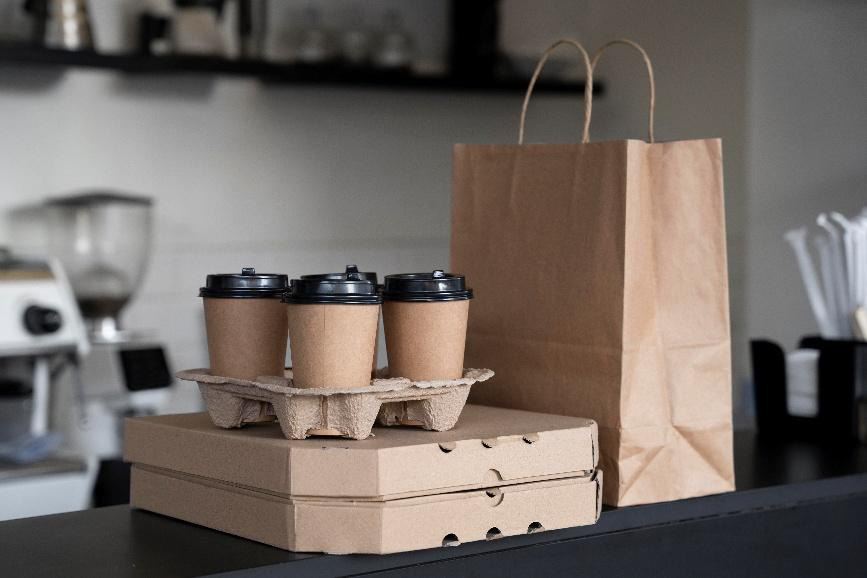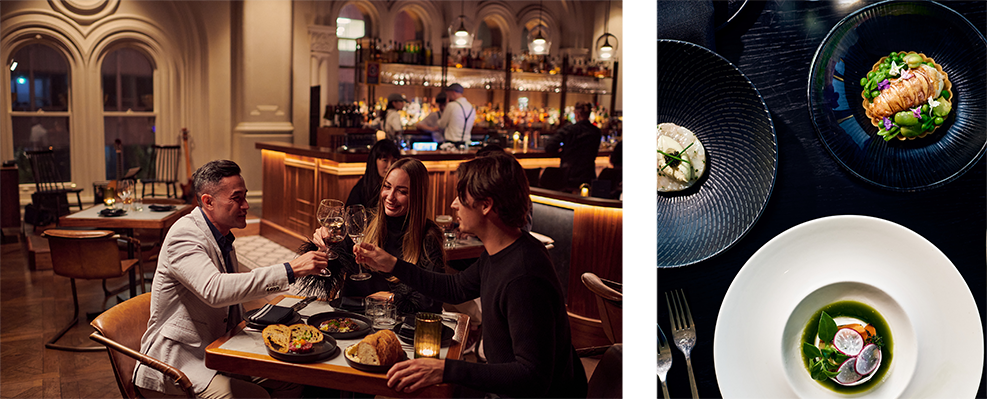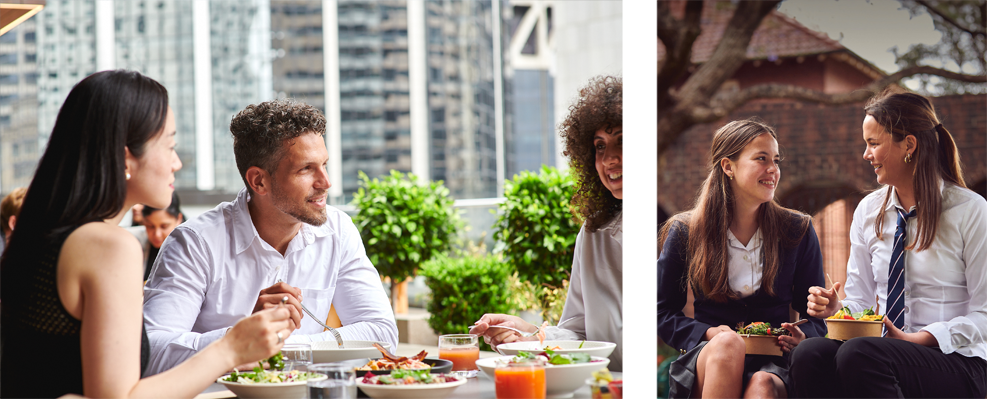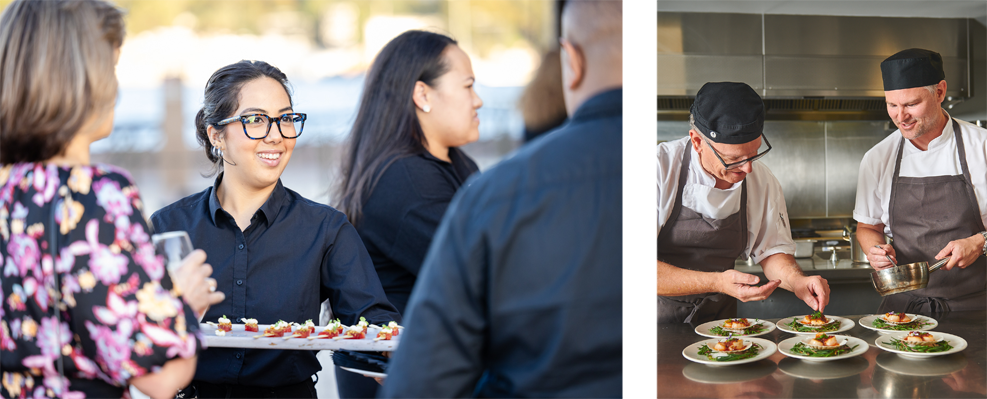The way we work has changed. So too should the way we eat at work.
Hybrid working isn’t just a scheduling quirk anymore, it’s a cultural shift. A new normal. A pattern of fluidity that has reshaped how people engage with the workplace and, crucially, with the services that used to orbit it. For corporate foodservice operators, this shift is both a challenge and an enormous opportunity.
Gone are the days of catering to a captive audience with predictable habits. Today’s workforce might be in the office two days a week, at home three, or dialling in from a co-working space or the back seat of an Uber between meetings. Amidst all this flux, one constant remains: people still need to eat. And they want to eat well, even when the rhythm of their week is anything but.
So, how do we cater to a workforce that’s no longer consistently present? How do we serve people who aren’t always there? The answer lies in embracing on-demand nourishment: a flexible, tech-enabled approach to workplace foodservice that meets employees where they are, literally and metaphorically.
The Myth of the “Lunchtime Rush” is Dead
Once upon a time, office catering revolved around the sacred lunch hour. From 12:30 to 1:30, people queued for a sandwich, hot plate, or salad bar. That was the core of the business. Predictable, plannable, profitable. That pattern is all but gone.
Hybrid workers often stagger their start times or work from home early in the week. Many treat their in-office days as hyper-efficient bursts, bookended by meetings, tight timelines, and little appetite (pun intended) for long lunch queues or scheduled breaks. If they’re only in the office for six hours, they’re not spending 45 minutes of it on a canteen bench.
This presents a problem for traditional foodservice models that rely on footfall, scale, and repetition. But it also opens up the field for reinvention.
From Canteen to Convenience: Reframing the Foodservice Offer
What’s needed is a shift from communal catering to custom convenience. This doesn’t mean eliminating dining areas altogether, far from it. But it does mean diversifying the offer to include formats that accommodate unpredictability, low attendance days, and changing consumer expectations.
Think grab-and-go fridges in the lift lobby, loaded with pre-packed, fresh items that change daily. Desk delivery that syncs with Outlook calendars, no need to interrupt a Teams meeting to eat well. Mobile ordering platforms that give users control over when and what they eat, with the added benefit of reducing waste and demand forecasting headaches. Micro-markets that operate unmanned but are stocked smartly, with contactless payment and usage tracking. Food hubs near hot-desking zones or breakout spaces, offering healthy snacks and meal kits that employees can grab on their own schedule.
This is about being present without being intrusive. Helpful, but not heavy-handed. Modern workplace foodservice should feel more like Spotify and less like school lunch.
Why App-Based Ordering Isn’t Just a Tech Gimmick
 Let’s talk tech. There’s been plenty of buzz around app-based ordering systems in workplace settings, but too often they’re seen as a novelty rather than a solution. The reality? Digital ordering is the backbone of hybrid-era catering.
Let’s talk tech. There’s been plenty of buzz around app-based ordering systems in workplace settings, but too often they’re seen as a novelty rather than a solution. The reality? Digital ordering is the backbone of hybrid-era catering.
A good workplace food app doesn’t just show today’s menu. It integrates with HR systems to forecast attendance and meal demand. It pushes personalised recommendations based on dietary preferences. It lets users schedule meals ahead of time, reducing peak congestion. It enables pre-payment or wallet functions to simplify transactions. It links into delivery options for those not at their desk or working from satellite offices. And when paired with decent data analytics, these apps give catering operators better visibility on what’s working, and what’s being wasted. This isn’t just convenience for its own sake. It’s operational intelligence disguised as a lunch order.
The Return of Rituals (Just Not the Ones You Remember)
Hybrid work disrupted the usual rituals of the office, morning coffees, team lunches, Friday drinks. But that doesn’t mean people don’t want rituals anymore. They just want different ones.
Food is still a key driver of social connection and workplace culture, perhaps even more so now that in-person days are precious and limited.
Smart catering strategies are leaning into this by curating ‘anchor days’ where food is used to draw people back in, think Tuesday Thai bowls or Wednesday wellness menus. Running ‘pop-up’ concepts that change weekly or monthly, global street food, chef’s table surprises, or menu collaborations. Offering shareable items for teams, think mezze platters or cookie boxes dropped at meeting rooms.
In short, food is being used not just to feed but to foster community, even if that community is only physically together twice a week.
Supporting the New Office Landscape
With hot-desking now the norm in many companies, and fewer fixed departmental zones, the layout of a workplace has become more fluid. The food offer needs to match.
It’s no longer about a single staff canteen at the basement level. Instead, we’re seeing satellite food stations on every other floor. Snack walls near collaboration zones. Mobile trolleys serving barista coffee or smoothies mid-morning. Self heating meal lockers that sync with app delivery.
This decentralisation mirrors the decentralisation of the workforce itself. And while it’s operationally more complex, it offers more touchpoints, more moments of delight, and more chances to integrate F&B into the employee experience.
It’s also better suited to organisations that operate across multiple campuses or large-format HQs. Consistency and accessibility become the name of the game.
Don’t Forget the Remote Workers
 One common blind spot in hybrid catering strategies? The at-home workforce. If 30–50% of your employees are working from home on any given day, shouldn’t your food strategy reflect that?
One common blind spot in hybrid catering strategies? The at-home workforce. If 30–50% of your employees are working from home on any given day, shouldn’t your food strategy reflect that?
Forward-thinking employers are trialling monthly meal credit schemes that can be used with approved vendors or apps. Healthy snack boxes delivered quarterly. Recipe kits for virtual team-building sessions. ‘Lunch & Learn’ packs tied to development programs.
These perks aren’t just about nutrition, they reinforce a sense of inclusion. They say: we see you, even when you’re not here. And yes, this does stretch the remit of ‘corporate catering’, but so what? The workplace has stretched too. And if you’re serious about supporting your people wherever they are, your foodservice model has to travel with them.
Reframing ROI: What Does ‘Success’ Look Like Now?
In traditional workplace dining, success was measured in covers served and cost recovered. In the hybrid age, it’s more nuanced.
You might need to consider engagement levels, app opens, feedback scores, participation in food events. Productivity metrics linked to wellbeing and meal quality. Talent retention and the role of benefits like food perks in employee satisfaction. Carbon footprint reduction via pre-ordering and smart stock control. Food waste levels, arguably now one of the most visible signs of mismatch between supply and demand. This new definition of success doesn’t always make for easy spreadsheets. But it aligns far more closely with how modern companies operate, and with what employees value.
Culture Eats… Well, Lunch
There’s a reason food keeps coming up in employee satisfaction surveys, even when hybrid models are the norm. It’s not because people are greedy. It’s because food remains one of the few tangible, sensorial, immediate touchpoints of company culture.
It’s where a generic corporate message becomes a lived experience. A “we care about your wellbeing” poster hits differently when it’s paired with a genuinely good grain bowl. An “inclusion matters here” campaign lands harder when halal, vegetarian, gluten-free, and allergy-safe options are always available, not just once a month. A “we’re flexible” policy feels more honest when people can eat when and how they want, without compromising on quality.
The Opportunity Ahead
The hybrid workforce isn’t going away. Nor is the expectation that employers will continue to support the wellbeing, productivity, and sense of belonging of their people.
For foodservice providers, this is the moment to lead, not just react.
- To think modular, mobile, and made-to-order.
- To use tech to humanise the experience, not de-personalise it.
- To balance quality with convenience, and consistency with flexibility.
And most of all, to treat workplace catering not as a line item, but as a strategic asset in the battle for talent, culture, and performance.
Because if the workplace of the future is part-office, part-home, part-hub… then the foodservice of the future needs to be all-in.










